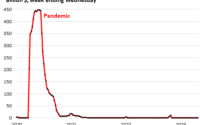BlackRock expects economy to flatline for a year before inflation returns in 2024. Get ready for a generational shift to ‘full-employment stagnation’
In December, BlackRock’s top minds told their clients that a U.S. recession was “foretold.” The Federal Reserve’s aggressive interest rate hikes, although meant to merely tame inflation, would ultimately lead to a wave of job losses and falling GDP, they warned. But now with inflation fading, GDP growth continuing, and the labor market remaining resilient, experts at the world’s largest asset manager have become a bit more optimistic about the future—at least in the near term.
“Our base case is that the economy broadly flatlines for another year as the full impact of high interest rates comes through and consumers exhaust their pandemic savings,” Jean Boivin, head of the BlackRock Investment Institute, and his deputy head, Alex Brazier, wrote in an Aug. 14 blog post.
A stagnant economy is slightly better than a shrinking one, but Boivin and Brazier noted that if their prediction is correct, the economy will have essentially “flatlined” for two and a half straight years. “That would be the weakest such period in the postwar era outside the Global Financial Crisis,” they explained, referring to the financial meltdown caused by the subprime mortgage crisis in 2008.
Boivin and Brazier also argue that a “big structural shift” is underway that could cause problems for the U.S. in the long term. Changing demographics and a rise in early retirements are increasing the share of retirees in the U.S. population. That could lead to labor force shortages, which would slow the economy and have the potential to reignite inflation.
“Our assessment is that we are set for ‘full-employment stagnation,’” the pair wrote Monday, arguing that as labor shortages start to “bind” in 2024, inflation will go on a “roller-coaster ride” and reemerge.
Out of the fire and into the frying pan
Over the past few years, changing consumer spending patterns and pandemic and war-related supply-chain issues helped to create a “mismatch” in the economy that sparked the rise of inflation, according to BlackRock.
Essentially, the economy wasn’t set up to produce what people actually wanted to buy, and this supply-demand imbalance caused prices to surge. But now, although that imbalance is “resolving,” enabling inflation to fade, the labor shortage is threatening to bring consumer price increases back with a vengeance.
Boivin and Brazier found that the U.S. workforce is 4 million workers short of where it would have been if it kept growing at its pre-COVID pace. And due to demographics, the pair believe it will now grow by only 0.5% on average each year, compared to 1.5% before the pandemic.
That could cause “full-employment stagnation,” or a period of weak growth with rising inflation caused by labor shortages. “And that should lead to a shift in how all the income generated in the economy is being distributed: A greater share is ending up in employees’ pockets and a smaller share for companies and their shareholders,” Boivin and Brazier explained.
Rising wages are great for workers, but with increased pay comes less profit and increased costs for business, and that “could hold back business investment” and stoke inflation, according to BlackRock. And on top of that: “A smaller workforce means the rate of growth the economy will be able to sustain without resurgent inflation will be lower: more like 1% than the 2% we were used to,” Boivin and Brazier warned.
Of course, some economists—and even billionaire CEOs—believe that rising wages are not necessarily an issue for the economy. Barry Sternlicht, the founder and CEO of Starwood Capital, told Fortune last September that even if rising wages push inflation higher, that might not be the worst tradeoff.
“I think the whole dialogue is wrong. I don’t think we need 2% inflation,” he said. “I mean, inflation that is driven by wage growth is fabulous. We should want wages to go up—that will help social issues in the United States. It’s the trickle-down that we’ve all been waiting for with low unemployment.”
A word of warning for the Fed
For the Federal Reserve, full-employment stagnation is a serious concern. Keeping inflation sustainably at bay amid labor shortages that cause steadily rising wages, while also ensuring that the economy continues to grow, will be a real challenge.
On top of that, the tactics used to spark economic growth in the past, including cutting interest rates or buying government bonds and mortgage backed securities, may prove to be far more inflationary amid future labor force shortages as lower rates and increased liquidity could lead to unsustainable wage gains.
With that in mind, Boivin and Brazier had a message for central bank officials:
“This is not a business cycle. We are in the midst of a structural shift. Monetary policy cannot rescue the economy from weakness. The Fed will need to make sure the U.S. economy is not growing more quickly than what it can now maintain without inflation surging.”
This story was originally featured on Fortune.com
More from Fortune:
5 side hustles where you may earn over $20,000 per year—all while working from home
Looking to make extra cash? This CD has a 5.15% APY right now
Buying a house? Here’s how much to save
This is how much money you need to earn annually to comfortably buy a $600,000 home
[ad_2]
Source link


